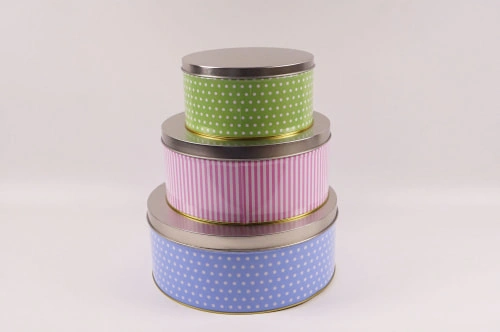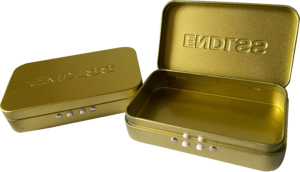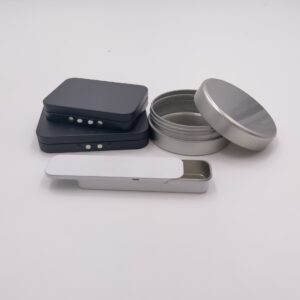As a crucial product in pharmaceutical packaging, child-resistant (CR) tin boxes must be carefully designed with safety functions in mind. In the pharmaceutical industry, packaging safety is essential for protecting patients, especially children in home settings.This article explores the core functionalities of CR tin boxes, providing an in-depth look at how locking mechanisms and sealing designs enhance packaging safety.
I.The Role of Child-Resistant Tin Boxes in the Pharmaceutical Industry
Demand for child-resistant packaging in the pharmaceutical sector continues to grow, especially for medications and nutritional supplements stored at home. To effectively reduce the risk of accidental ingestion by children, CR tin boxes must incorporate specific safety features. These features not only protect the safety of patient households but also ensure compliance with regulations such as those set by the FDA and the European Union. For product designers, creating compliant safety features is critical.
II.Key Locking Mechanisms for Child-Resistant Tin Boxes
Locking mechanisms are among the most important design features in CR packaging. The purpose is to ensure that the tin can only be opened through specific actions, preventing unintentional access by children. Below are some common locking mechanism designs and their applications in child-resistant pharmaceutical tin boxes.
- Press-and-Turn Mechanism
The press-and-turn lock is a common CR mechanism that requires the user to simultaneously press and twist the lid to open it. This design adds an extra layer of difficulty for children while allowing adults to open the tin box with ease.
- Design Tips: Ensure the pressing and twisting force is suitable, allowing adults to operate easily while preventing children from opening it. The press area can be enhanced with texture or color markings for better visibility.
- Ideal Applications: Suitable for packaging solid or capsule medications, especially those commonly stored at home.
- Dual-Locking Mechanism
A dual-locking mechanism requires the user to perform two different actions to unlock the tin, often a press-and-pull combination, providing an even higher level of security. Although this design is more complex, it is effective for packaging medications requiring a high degree of child protection.
- Design Tips: Ensure precision in the locking parts to prevent adult user errors. The dual-locking design can be implemented through internal gears or snaps to enhance security.
- Ideal Applications: Ideal for packaging high-potency drugs, particularly for long-term storage.
- One-Way Opening Mechanism
The one-way opening design requires the user to apply force from a specific direction (such as the right or left side) to open the box, making it difficult for children to operate while being easy for adults. This design has high requirements for directionality and structural integrity.
- Design Tips: Ensure the one-way opening structure is sturdy and allows easy adult access. Resistance strips or small springs in the opening area can add difficulty to opening.
- Ideal Applications: Suitable for small medication packaging, especially those with a high risk of accidental ingestion.
III. Key Sealing Design Considerations
In addition to locking mechanisms, sealing is also an essential function in CR tin boxes. Sealing not only prevents moisture and oxidation of the medications but also further ensures safe storage in case of accidental opening.
- Moisture-Resistant Sealing Design
Many medications, particularly tablets and capsules, are sensitive to humidity. Therefore, CR tin boxes in the pharmaceutical industry must have effective moisture-resistant features to ensure long-lasting storage.
- Design Tips: Add rubber seals along the inner walls of the tin to improve airtightness or use materials with moisture-resistant coatings to reduce the risk of water ingress.
- Ideal Applications: Suitable for medications that require long-term storage at room temperature, such as antibiotics and vitamins.
- Contamination Prevention Design
In addition to moisture resistance, pharmaceutical packaging must consider contamination prevention to avoid dust, microbes, or other pollutants from affecting the medication quality.
- Design Tips: Use multi-layer sealing structures to prevent dust and microbes from entering the packaging. An additional plastic seal on the outside of the tin can further prevent contamination during transport and storage.
- Ideal Applications: Suitable for long-term storage medications, ensuring the safety of drugs over extended shelf lives.
- Anti-Damage Design
Durability is also essential in the pharmaceutical industry, especially for reusable medication containers. The impact resistance and durability of the tin box directly influence medication safety. The anti-damage function of tin boxes can be achieved by reinforcing the connection between the lid and the box.
- Design Tips: Add thickness to the edges of the tin and place springs or anti-slip features between the lid and the box body to enhance overall resistance to pressure.
- Ideal Applications: Suitable for fragile medication packaging, ensuring stability during transport and storage.
- Case Study: Integrating Locking Mechanisms and Sealing Features for Enhanced Safety
The following case demonstrates how combining locking mechanisms and sealing features effectively enhances the safety of child-resistant tin boxes:
- Case Study: A Global Pharmaceutical Brand’s Child-Resistant Tin Box
This brand’s design utilizes a press-and-turn lock mechanism with an additional rubber seal inside. The design ensures security when opening and prevents air and moisture from entering the tin box, keeping medications fresh over time. The anti-slip design on the inside of the lid ensures that children cannot easily open it, while adult users can operate it easily with guidance, earning high customer satisfaction.
This case illustrates the dual advantages of combining locking and sealing features, making the product highly suitable for home and medical storage environments.
- Conclusion: Balancing Safety and Usability in Design
The design of child-resistant tin boxes should focus on functional safety while also considering user experience. By carefully selecting locking and sealing options, product designers can ensure that tin boxes effectively protect medications from children while remaining accessible to adults. CR tin boxes will become an increasingly important tool for pharmaceutical safety in the future.
With these design considerations, product designers can gain a comprehensive understanding of child-resistant pharmaceutical packaging needs, creating solutions that are both safe and user-friendly.





![CR tin Secure and Stylish Child-Resistant Tin Packaging for Safe Storage At [Your Company Name], we specialize in innovative child-resistant tin packaging solutions designed to meet the highest safety standards while enhancing your brand's visual appeal. Our child-proof tins are perfect for a variety of industries, including pharmaceuticals, cannabis, and household products, ensuring that safety and functionality go hand in hand. Our child-resistant containers are crafted with precision, employing a patented locking mechanism that is simple for adults to use but challenging for children, effectively reducing the risk of accidental access. Each tin is constructed using high-quality, durable materials that offer excellent protection against contamination and damage, making them ideal for both child-safe packaging and adult use. Safety is at the forefront of our design process, but we do not compromise on aesthetics. We offer custom tin packaging options that allow you to tailor the look and feel of your products to match your brand identity. With advanced printing and embossing techniques, your packaging is not just secure but also visually appealing, enhancing shelf presence and consumer attraction. Our tins are also environmentally friendly, aligning with current trends in sustainable packaging. They are reusable and recyclable, supporting your company's green initiatives. Choose from a variety of sizes and shapes to fit your specific needs, whether for cannabis packaging, pharmaceutical containers, or any other products requiring stringent safety measures. By choosing [Your Company Name], you are opting for child-resistant packaging that protects your products and your end users. Our tins meet all regulatory requirements for child-resistant effectiveness, providing you with peace of mind and your customers with safe, accessible solutions. Keywords: child-resistant tin packaging, child-proof tins, child-safe packaging, custom tin packaging, sustainable packaging, cannabis packaging, pharmaceutical containers.](https://goldentinbox.com/wp-content/uploads/2024/05/CR-tin-goldentinbox-2-s.webp)





